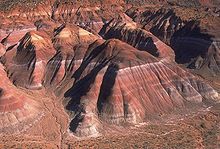Chinle Group
| Chinle Formation Stratigraphic range: Late Triassic |
|
|---|---|

Chinle Badlands, Grand Staircase-Escalante National Monument, Utah, US.
|
|
| Type | Geological formation |
| Sub-units | Shinarump Conglomerate, Mesa Redondo Member, Bluewater Creek Member, Blue Mesa Member, Sonsela Member, Moss Back Member, Petrified Forest Member, Owl Rock Member, Rock Point Member, Church Rock Member |
| Underlies | Wingate Sandstone or Moenave Formation |
| Overlies | Moenkopi Formation or Cutler Group |
| Lithology | |
| Primary | fluvial mudstone, siltstone, and sandstone |
| Other | paleosols |
| Location | |
| Region | Colorado Plateau |
| Country | United States |
| Type section | |
| Named for | Chinle, AZ |
| Named by | Herbert E. Gregory |
The Chinle Formation is an Upper Triassic continental geologic formation of fluvial, lacustrine, and palustrine to eolian deposits spread across the U.S. states of Nevada, Utah, northern Arizona, western New Mexico, and western Colorado. The Chinle is controversially considered to be synonymous to the Dockum Group of eastern Colorado and New Mexico, western Texas, the Oklahoma panhandle, and southwestern Kansas. The Chinle is sometimes colloquially named as a formation within the Dockum Group in New Mexico and in Texas. The Chinle Formation is part of the Colorado Plateau, Basin and Range, and the southern section of the Interior Plains.
A probable separate depositional basin within the Chinle is found in northwestern Colorado and northeastern Utah. The southern portion of the Chinle reaches a maximum thickness of a little over 520 m. Typically, the Chinle rests unconformably on the Moenkopi Formation.
There is no designated type locality for this formation. It was named for Chinle Valley in Apache County, Arizona by Herbert E. Gregory in 1917 without officially designating it as the formation's name until two years later and without a specified type locality.United States Geological Survey economic geologist Raymond C. Robeck in 1956 revised the unnamed members of Gregory by identifying and naming the Temple Mountain member as the basal-most unit in the area of the San Rafael Swell of Utah. In 1957 John H. Stewart revised the Shinarump Conglomerate of G. K. Gilbert, 1875, and Edwin E. Howell, 1875, and Gregory, 1917, and renamed it the Shinarump member of the Chinle formation. An overview of the geology of the area was created by USGS geologist Forrest G. Poole and Stewart in 1964. Sikich revised the unit and assigned more members assigned in 1965. The areal extent of the unit was mapped by Wilson and Stewart in 1967. In 1972 the areal limits were modified and an overview created by Stewart and others (they published a revision the same year). Kelley assigned more members and revised the unit in 1972. Lucas and Hayden did the same thing in 1989. The Rock Point Member was assigned by Dubiel in 1989. The Chinle was raised to group status by Lucas in 1993, thus also raising many of the members to formation status. He also included the formations of the Dockum Group of eastern New Mexico and west Texas within the "Chinle Group" . This modified nomenclature is controversial; many still retain the Chinle as a formation and separate out the Dockum Group (e.g., USGS). The Dockum was named in 1890, before the Chinle. If Lucas is correct, his "Chinle Group" should be named the Dockum Group due to stratigraphic nomenclature rules. Overviews of the Chinle were created by Dubiel and others (1992) and Hintze and Axen (1995).
...
Wikipedia
